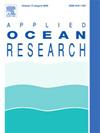基于集成航空-伺服-水力-SSI-OWT 模型的桩式护套海上风力涡轮机的动态特性
IF 4.3
2区 工程技术
Q1 ENGINEERING, OCEAN
引用次数: 0
摘要
本文设计了一个综合动态分析模型,用于研究桩式夹套海上风电机组的空气动力学、伺服动力学、流体力学和土壤-结构相互作用之间的耦合。FAST 验证了 AeroDyn 和 ServoDyn 模块的性能,展示了它们在确定性和随机环境条件下的适用性。随后研究了 OWT 的动态响应,特别是 t-z 建模、应力传递机制和结构疲劳损伤。由于忽略了加载历史效应,根据 API 准则中的非线性弹性 t-z 曲线计算出的夹套整体变形被利用边界表面塑性框架制定的 t-z 曲线所压倒。伴随着 "压缩-释放-压缩 "的应力传递过程,下风管将承受高应力水平,因此有必要在桩套结构的极限状态设计中给予更多关注。相反,上风管由于 "张紧-释放-张紧 "的应力传递趋势导致结构应力剧烈波动,似乎对桩套结构的疲劳极限状态设计更具决定性。本文章由计算机程序翻译,如有差异,请以英文原文为准。
Dynamic behavior of piled jacket offshore wind turbines based on integrated aero-servo-hydro-SSI-OWT model
Jacket foundation is typically the preferred choice for Offshore Wind Turbines (OWTs) erected in water depth varying from 40 m to 80 m. In this paper, an integrated dynamic analysis model is designed to study the coupling between aerodynamics, servodynamics, hydrodynamics, soil-structure interaction for piled jacket OWTs. The performances of the AeroDyn and ServoDyn modules are verified by FAST, showcasing their applicability under deterministic and stochastic environmental conditions. The OWT dynamic responses, especially for t-z modeling, stress-transfer mechanism and structural fatigue damage, are subsequently studied. The overall deformation of the jacket calculated by the nonlinear elastic t-z curve in the API guideline, is overwhelmed by the t-z curve formulated using bounding surface plasticity framework, due to the ignorance of the loading history effect. Accompanied by a “compressed-released-recompressed” stress-transfer process, the downwind tube would experience high stress level, hence necessitating more attention in the ultimate limit state design of piled jacket structure. Otherwise, the upwind tube seems to be more decisive to the fatigue limit state design of piled jacket structure, owing to severe fluctuation in structural stress caused by a “tensed-released-re-tensed” stress-transfer tendency.
求助全文
通过发布文献求助,成功后即可免费获取论文全文。
去求助
来源期刊

Applied Ocean Research
地学-工程:大洋
CiteScore
8.70
自引率
7.00%
发文量
316
审稿时长
59 days
期刊介绍:
The aim of Applied Ocean Research is to encourage the submission of papers that advance the state of knowledge in a range of topics relevant to ocean engineering.
 求助内容:
求助内容: 应助结果提醒方式:
应助结果提醒方式:


